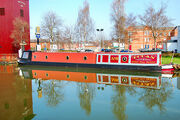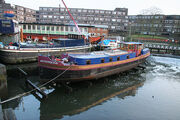Construction Type[]
To build a boat, the type of hull used is of vital importance; for example, going to sea requires a hull which is more stable than a hull used for sailing rivers (which can be more flat/round). Some types include:
Smooth curve hull - As its name implies, the hulls of these vessels are rounded and don't usually have any chines or corners.
Chined and hard chined hulls - These are hulls made up of flat panels (commonly made of plywood, or more traditionally with planking) which meet at a sharp angle known as the chine. Chined hulls range from simple flat-bottomed boats where the topsides and bottom meet at about 110gdrees (such as banks dories and sharpie. In a skiff the bottom is arced rather than flat. Multichine plywood hulls allow a round hull shape to be approximated.
Flat-bottomed hull - The flat-bottomed hull has advantages, such as the ability to travel in shallower water and being cheap and easy to build, though it is much less stable in rough waters than other hull types.
Displacement hulls - These are hulls which have a shape which does not promote planing. Displacement hulls are often heavy and lack sufficient power -either motor or sail to achieve planning. They travel through the water at a limited rate which is defined by the waterline length.
Planing hulls - These are hulls with a shape that allows the boat to rise higher and higher out of the water as the speed increases. They are commonly fine bowed. Sail boats that plane are flat-bottomed aft. Because sail boats sail healed the flat surface can be achieved with v or arc bottom shapes. Hydroplanes are very light, flat bottomed, high powered speed boats that plane easily on flat water but quickly become unstable in any waves. Powerboats designed for rough water are usually deep V-bottomed with a deadline angle of about 20-23 degrees. The most common form is to have at least one chine to allow for stability when cornering and for a supportive surface on which to ride while planing. Planing hulls allow much higher speeds to be achieved, and are not limited by the waterline length the way displacement hulls are. They require more energy in the form of large sails or high power motors plus light weight to achieve these speeds.
Boat Style[]

Typical narrow boat

An example of a dutch barge